
The breed
type “Spaniel” was first referred to in the XIV
century. In his Book of Hunting "Le Livre de la chasse"
Gaston Phoebus de Foix - a feudal landowner- mentions Spaniels….”fair
Spaniels”, already. He wrote: "There´s another
kind of dogs….....hounds for the hawk. Spaniels of their
manner come from Spain. Such a hound for the hawk should have
a great head, a great body, be of fair hue. White or tavele
for they be the fairest and of such hue as is commonly the best.
The good qualities of such hounds are these…..they
love their master and follow him without loosing him, notwithstanding
if they are located in a big crowd of people….mostly they
run ahead their master, dashing and wagging their tails, and
let flush the winged game….but their real skill is focussed
on quails and partridges. When they were taught to lay before
than they are qualified to catch partridges and quails with
the net……and if they have learned to swim they are
good for the river and the duck shooting".

As of May 1387, Count of Foix and Viscount of
Béarn, Gaston Phoebus wrote the “Book of hunting”
(Le Livre de la chasse) and dedicated it to his hunting companion
“Phillip dem Kühnen” in 1389.

There are
some legends about the arising of this breed. However non-controversial
that the Spaniels that we now know as Clumber come from Clumber
Park in Nottinghamshire. One of these legends implies the breed
have been bred from spaniels, which the Duc de Noailles at the
time of the French Revolution in the late 18th century gave with
his kennel of prized spaniels to the Duke of Newcastle at Clumber
Park. It has been theorized that the Duke of Newcastle's long
time gamekeeper, William Mansell, was himself responsible for
the development of this unique breed. Probably get through the
selection of the best working dogs to find a suitable dog for
these purposes. It is known that he and his descendants worked
in that area for a long time with a significant number of hunting
spaniels. The earliest description of the Clumber is from the
year 1861 by John Meyrick, who described him as " the largest
variety of Spaniel, weighing sometimes as much as 30lbs."
.... - Much smaller than the Clumbers as we know them today!
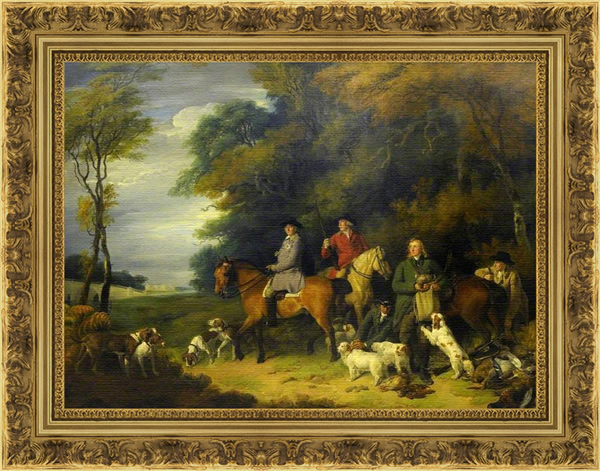
First pictures of this original Clumber Spaniels on the painting
of Francis Wheatley of 1788
which now is to be seen in Clumber Park and shows the 2nd Duke
at the hunt with his dogs.

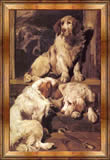
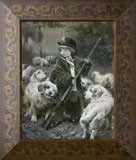
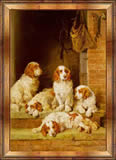

From his
kennel the Duke then shared dogs with his neighbours at the
country seats in the Dukeries (this is also the explanation
for our kennel name).The Dukeries is a district in the county
of Nottinghamshire so called because it contained four ducal
seats. It is south of Worksop which has been called the Gateway
to the Dukeries.
The ducal seats were:
Clumber
House : principal seat of the Dukes of Newcastle.
Thoresby Hall : principal seat of the Dukes of Kingston and
later of the Earls Manvers.
Welbeck Abbey : principal seat of the Dukes of Portland
Worksop Manor : a seat of the Dukes of Norfolk
Near Worksop
Francis John Savile Foljambe of Osberton Hall then became well
known for his Clumbers, the prize winning Nabob and notably
Beau “pillar of the stud” in 1872.
The Clumber spaniel was shown in England from 1859 onward and
officially recognised as a breed in 1879.

The Clumber Spaniels have been favored by the Royals. Kept and
bred by Prince Albert,
King Edward VII, King George V and more recently HRH Princess
Anne the Princess Royal.
Prince
Albert, the Prince consort of Queen Victoria, was a fancier
and promoter of the breed, as was his son King Edward VII, who
bred them at the Sandringham estate in Norfolk. They are referred
to in Queen Victoria's diary:
On October 16, 1840, she wrote, "Walked out directly after
breakfast before Albert went to shoot. He had his 7 fine Clumber
Spaniels with us and we went into the Slopes, with such a funny
old Gamekeeper, Walters, in order that I should see how the
dogs found out their game. They are such dear, nice dogs."
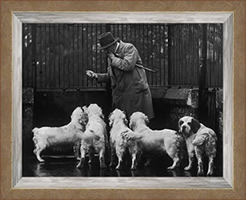
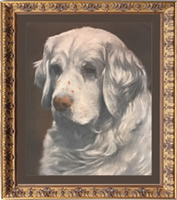
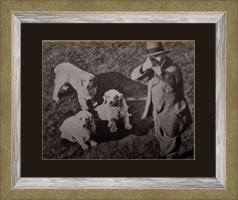
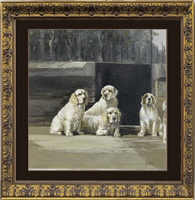
The breeding
of the Clumber Spaniel was mostly reserved to the nobility until
the mid 19th century. During World War I breeding was stopped
and their numbers dropped to a record low. King George V. re-developed
a line of Clumbers in the Royal Kennel in 1925 and this dogs
were used in the fields in the Sandringham Estate.

In 1891 Cruft's developed from a pure terrier show to exhibiting
all dogs, including Clumber Spaniels. An advertisement for Mr
James Thorpe Hinck’s stud dogs ‘Friar Trounce’
and ‘Friar Bob’ claim them to be both “well
broken and excellent workers”. Friar Bob being a direct
descendent (6th generation) of Nabob of
1872. In the beginning of the last century Clumber were used as
working dog as well as show dog. Kennels like "Beechgrove",
"Heathmynd" and "Hempstead" bred Clumber Spaniels
that had been both ....successful in the show ring and in the
field.
The first Field Trials were given in 1899 and Clumber were represented
in a high number.


Mr. F.
Winton Smith's Clumber Champion Beechgrove Donally (top right),
a dog that has remained practically unbeaten in the show-ring:
several of his offspring have performed creditably at the trials.
The picture left shows another of Mr. Winton Smith's famous
Clumbers, Champion Beechgrove Bee, a bitch that has won the
rare distinction of a title gained at trials alone; for she
has never been exhibited.
During
World War II the breeding of Clumber became less and they were
only kept as show- and family dogs. The dogs were bred against
the breed standard more for show than for looking on the abilities
for work. The breed standard now was determinate by heavier
dogs than the original Duke of Newcastle’s spaniels. The
Breed became rarer and their reputation as working dogs was
damaged. They were known as clumsier and more dawdling Spaniels,
nothing for a fan of working dogs. Cocker and Springer now were
preferred for hunting.
At the
beginning of this century the registration numbers of Cocker-
just like Springer Spaniels - in Great Britain
were almost one hundred times of the registered Clumber Spaniels.
But in
the last few years some Breeder in GB made a reversion and thereby
the numbers of Clumber Spaniels are increasing.

|

![]() 2011 - 2023 Hinweis
2011 - 2023 Hinweis